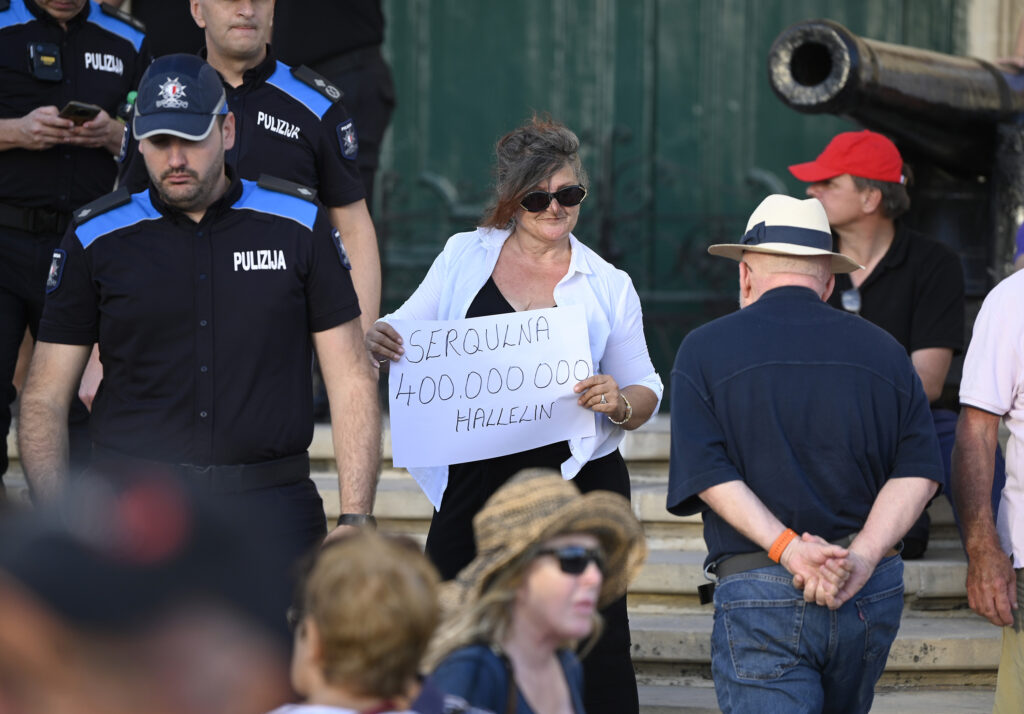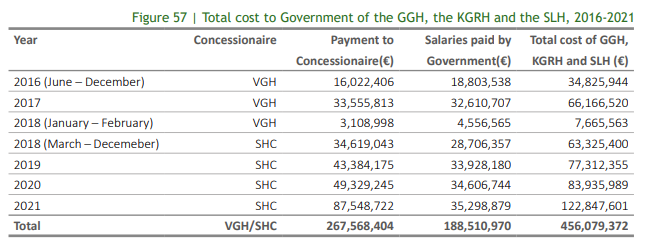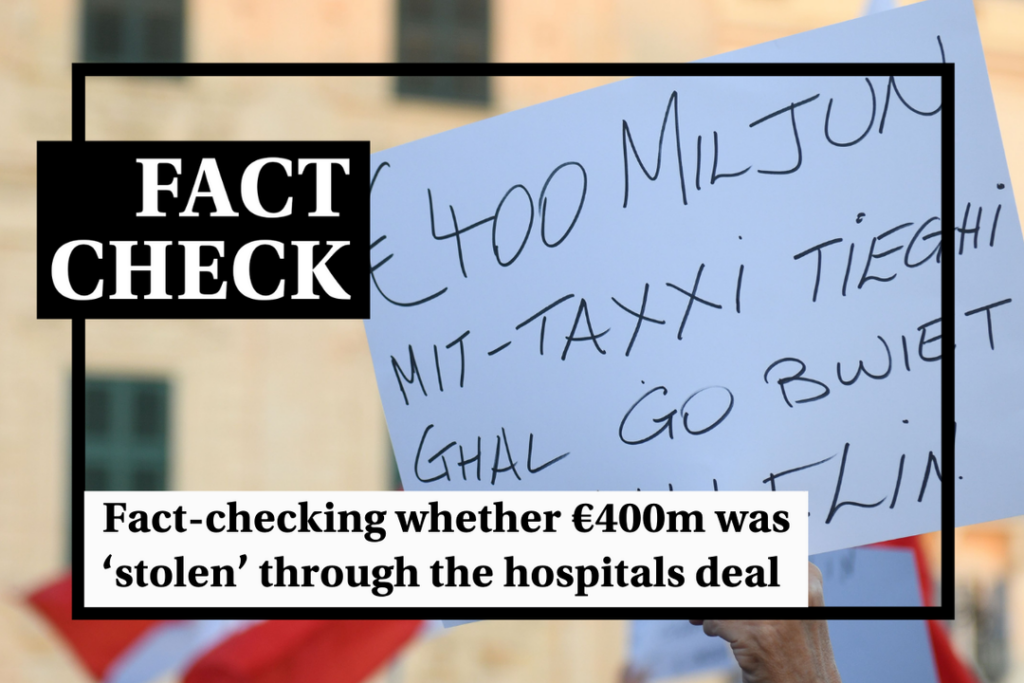In the latest twist to the saga over the fraudulent hospitals concession, the opposition took the State Advocate to court in December, demanding that the state recover the “€400m that were given to Vitals and Steward”.
The move concerns a controversial concession deal signed by the Maltese government granting private healthcare companies Vitals and Steward Healthcare guardianship of three of Malta’s public hospitals. The deal, initially signed in 2016, was scrapped in early 2023, with courts describing it as “fraudulent”. The court’s decision was confirmed later in the year, after Steward had filed an appeal to overturn the decision.
This €400m figure has become the yardstick by which the scale of the fraudulent deal is measured, but the figure itself has been disputed.
On the one hand, opposition members have repeatedly claimed that €400m were “stolen” from the Maltese taxpayer.
The government, in turn, has accused opposition leader Bernard Grech of misleading the public, arguing that the €400m figure includes legitimate expenses that would have been incurred even if the concession did not exist, such as workers’ salaries.
Several readers have written to Times of Malta over the past months, hoping to understand what the actual cost of the deal was and whether this includes salaries.

Do we know exactly what the deal cost?
Not quite, but we can get pretty close by patching together different bits of information in the public domain.
Earlier this year, a Times of Malta report sifted through the labyrinthine figures of the deal, estimating that taxpayers forked out €448m to Vitals Global Healthcare and Steward between 2016 and 2022.
The most recent National Audit Office (NAO) report into the deal, published a few months later, listed a similar figure, saying that the deal cost €456m in total by the start of 2022.
The NAO report represents the most accurate indication of the cost, but it doesn’t include the costs incurred throughout 2022 and the first two months of 2023, before the deal was scrapped in February of this year.
Does the €456m include salaries?
Yes, it does.
Of the €456m reported by NAO, a little under half, or €188.5m, were salaries that went to hospital workers. Salaries were paid directly by the government, so this money didn’t form part of the allocation given to either Vitals or Steward.
In simple terms, the government loaned its staff to Vitals and Steward but kept them on its own books.
The remaining €267.5m were payments that were meant to go towards keeping the hospitals running, supposedly to the same standards that they did before the deal came into place. They include things such as medical equipment, beds, and maintenance.

This means that while the overall cost of the deal is higher than the €456m flagged by the NAO, a significant portion of these costs did go towards either paying workers’ salaries or keeping hospital services running in the same way they did before the deal was ever conceived.
The deal never moved beyond its initial transition phase, during which VGH and Steward were obliged to keep the same standard of care that existed before the concession was signed. This means that this money was not earmarked for the infrastructural investments that VGH and Steward had promised, but ultimately never carried out.
So where does the €400m number come from?
PN insist that the €400m they are demanding be returned do not include salaries.
Former PN leader Adrian Delia, who successfully led the charge against the deal, explained their calculations in a fiery speech in parliament last month.
Taking the €267.5m figure mentioned by NAO as a starting point, Delia added the government’s budget allocations for the concession for 2022 and 2023 to the total, since NAO’s figures stop short of these years.
This would bring the total up to just over €416m until the end of 2023, had the courts not intervened and scrapped the deal at the beginning of the year.
But this also means that Delia’s calculations also include almost a full year, from March 2023 onwards, during which the deal had been scrapped and the hospitals returned to the government.
What if payments stopped when the concession was scrapped?
As things stand, while it is fair to assume that the full payment for 2022, amounting to €69m, was paid to Steward, it is likely that only a fraction of the €79.5m allocated for 2023 was actually paid out, before the deal was cancelled two months into the year.
If we had to estimate this amount pro-rata, this would amount to a little over €13m.
This would bring the total cost of the deal, excluding salaries, up to just under €350m, following the same method of calculation as Delia.
In practice, it is almost impossible at this stage to accurately estimate how much of these funds went towards legitimate costs needed to run the hospitals, and how much can’t be accounted for.
However, both the NAO and the courts were damning in their verdicts, saying that the deal was fundamentally fraudulent and the government did not get its money’s worth.
Meanwhile, a legal battle between the government and Steward is underway at the International Chamber of Commerce arbitration court in Paris.
On the one hand, Steward is demanding that they receive a €100 million cancellation fee engineered by then-minister Konrad Mizzi. On the other, the government is refusing to pay up and demanding monetary compensation from Steward for breaching its contractual obligations.

Verdict
The government spent a total of €456m to run the hospitals since the deal was signed in 2016 until beginning of 2022. A little less than half of that (€188.5m) went towards paying workers’ salaries, while the remaining €267.5m was intended to go towards routine hospital running costs such as equipment, maintenance and beds.
Updating these figures to include 2022 and the first two months of 2023, before the deal was scrapped by the courts, suggests that the total amount awarded to Vitals and Steward, excluding salaries, is likely to have been around €350m.
It is difficult to estimate how much of this money went towards legitimate costs, but the auditor general and the courts agree that the government did not get its money’s worth.
The Times of Malta fact-checking service forms part of the Mediterranean Digital Media Observatory (MedDMO) and the European Digital Media Observatory (EDMO), an independent observatory with hubs across all 27 EU member states that is funded by the EU’s Digital Europe programme. Fact-checks are based on our code of principles.
Let us know what you would like us to fact-check, understand our ratings system or see our answers to Frequently Asked Questions about the service.





